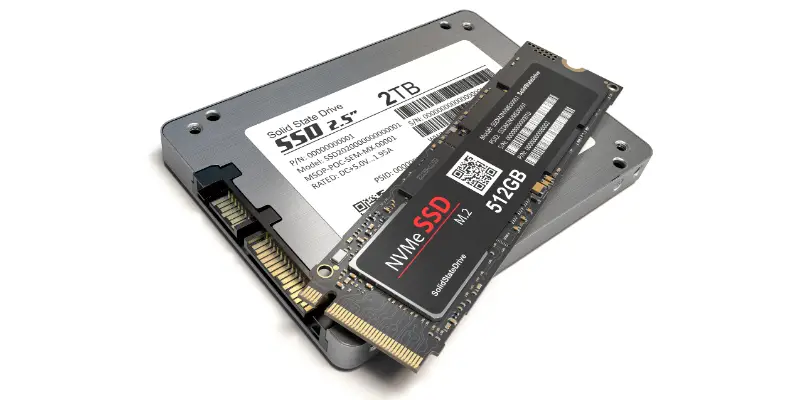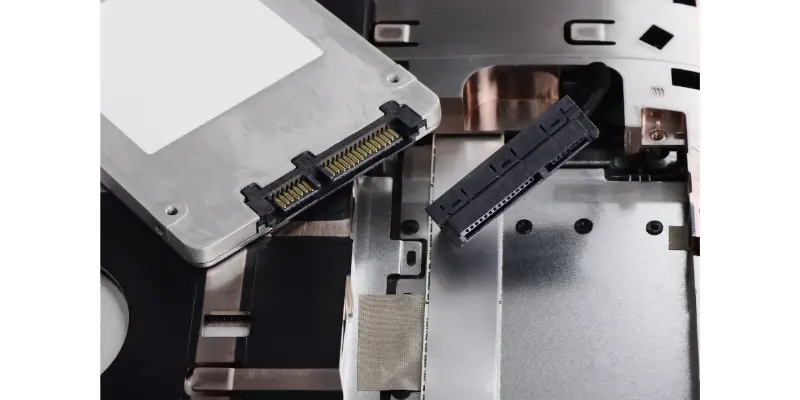Disclaimer: This post may contain affiliate links, meaning we get a small commission if you make a purchase through our links, at no cost to you. For more information, please visit our Disclaimer Page.
Whether you’re buying a laptop or desktop, you’re likely considering whether you want to get an SSD. You might be wondering, “Are laptop and desktop SSD the same?”
The laptop and desktop SSDs are the same when it comes to compatibility. You may use the same SSD on a laptop or a PC, which cannot be done with an HDD. There are technicalities behind this, whereas some are also reasons behind the difference between the two.
Table of Contents
Is There A Difference Between an SSD For a Laptop And An SSD For A Desktop?
It may come as a shock to people who are not tech-savvy, but there is no difference between an SSD for a laptop and an SSD for a desktop. Almost all SSD (Solid-State Drive) come in a 2.5″ form factor which is commonly used in both laptop and desktop devices. I noted almost because there is also a 3.5″ available in the market, though the 2.5″ size is the most commonly used by PC and laptop owners nowadays.
SSD storage devices differ depending on the amount of bits that have been stored in each cell with the most dependable, long-lasting and fastest being single-bit cells (“Single Level Cells” or “SLC”). The downside however is that single-bit cells are the most expensive type, compared to the 2- and 3-bit cells (“Multi-Level Cells/MLC” and “Triple-Level Cells/TLC”). A quad-bit (“QLC”) cell is the cheapest choice for devices with no extreme characteristics and the cheapest per Gigabyte of all four.
The only difference that I can think about is not about the SSDs, but rather the desktop’s enclosure that might cause that difference. Laptops are known to have almost the same size when it comes to the sockets meant for every component such as the space for placing the SSD. However, the enclosure for desktops varies a lot. There might be a size that’s meant for both HDD and SSD to be perfectly installed inside, or it might be small enough to fit only the HHD.
Note: For those who are unfamiliar, a computer’s form factor relates to the size, shape, and physical characteristics of hardware or hardware components. The term “computer form factor” refers to any physical element of a computer system. The form factor is critical for connection compatibility. You’ll read more about form factor throughout the post because it helps clarify the physical characteristics of an SSD, especially for novices.
Are Laptop And Desktop SSD The Same?
Both SSD for the laptop and SSD for the desktop are the same. The SSD serves its purpose as second storage and can nowadays hold up to a capacity of 250GB to 100TB. SSDs are typically physically more shock resistant, run silently, offer higher speed of access and lower latency in comparison with electromechanical drives. In layman’s terms, An SSD is both quiet and can boot faster than an HDD.
Though keep in mind that the 2.5″ is commonly used in laptops but can be used on a desktop with the usage of a bracket to fit a 3.5″ slot. When gaming is a factor, An SSD is a must. Faster loading times and image or graphics pre-rendering would be great. Games that have a lot of assets, and use a lot of resources, would benefit your rig if you have an SSD especially games. Online games that use a lot of assets, such as popular online FPS and battle royale games, will benefit greatly from an SSD as well.
As you can see, the main similarity of both types of SSDs, as well as their size is the performance. The only factor that might vary the performance of an SSD is not whether if the device fits a laptop or to a desktop. It all relies on the size of the SSD, as well as the overall quality of the product. To find out more about the product’s quality, it is highly suggested to check out the brand of the device, as well as its reviews from the users who bought it.
Tip: SSDs are must-haves for your machine, whether it’s a laptop or a desktop. I would recommend going with the flexible pick, alongside installing it with just its supposed operating system. Grabbing an SSD would help you out in the long run especially if you are using a lot of resources such as playing games. An SSD is also very quiet, which can help you focus on the tasks at hand.
Now that you’re aware of every single difference and similarity that desktop and laptop SSDs have, it’s also time for you to check the compatibility of both SSD types. In this way, you will understand if a laptop SSD fits a desktop or the other way around.
Can You Put A PC SSD In A Laptop?
This might be possible, or not at all. The situation actually depends on the size of the SSD itself, rather than the compatability of an SSD As I stated before, nowadays almost everyone uses a 2.5″ SSD. It means that yes, you can use a PC SSD and put it inside a laptop if the SSD itself is 2.5″ form factor. All you have to do is remove the bracket so it can fit in the 2.5″ slot.
Also, keep in mind that an SSD uses less power than a standard HDD. This means you will get the benefit of having a longer battery life for your laptop, which is a huge factor in keeping your laptop even longer in terms of both usability and durability. An SSD also helps with keeping the apps running on the system to keep on responding. This is why switching to a laptop, especially when trying to fix or re-assemble your PC, is very easy to do.
According to several users, it also seems like running an SSD instead of an HDD on a laptop is better. Though if you have an older PC, most likely the SSD inside would be 3.5″. If that is the case, then there is no way you can fit the 3.5″ SSD in the laptop. This is the main reason why most users prefer using the 2.5” SSDs. In that way, they can transfer the storage device to a PC or to a laptop without any problem, especially when backing up some stuff.
Can You Put A Laptop SSD In A PC?
It is way easier to put a laptop SSD in a PC than the other way around. The form factor of an SSD found in a laptop is 2.5″ hence it would fit in a Desktop with a 3.5″ slot. You could use an enclosure or a bracket to fit it in the 3.5″ drive slot so that it won’t fall. Other PC owners even joked that you can just tape it on the walls of the inside of the case.
If you’re ever wondering “what do other people put in their SSD?”, basically most people put the Operating System on the SSD due to its speed. An SSD allows faster OS boot up if done this way. Also, keep in mind, an SSD uses less power than a standard HDD. This is why I find it easy to upgrade from a laptop to a PC. When I upgraded from a laptop to a PC, I had no difficulty setting up my operating system since it’s up-to-date, so I just went ahead and moved my SSD to my new machine.
For a desktop, especially for a gaming rig, an SSD comes in like a miracle when helping you save costs on your electricity bill. Just imagine how much you’d be saving especially if you’re opening in games with massive effects, such as open-world games with several sidequests and a huge database of monsters and items to see.
But take note that if money-saving is your priority, particularly on your bill, it would be best if you are using a gaming laptop. Though, expect the best gaming laptop to perform a little bit less than a gaming rig with the best specifications.
Conclusion
Desktop and laptop SSDs are the same in terms of the tasks it performs. You can put a laptop SSD in a PC but a PC SSD in a laptop depends on the size of said SSD. The only difference would be the form factor of the SSD and the smaller SSD sizes that most users have nowadays in their machines.


